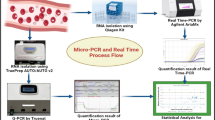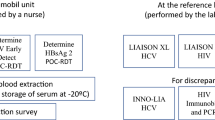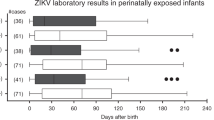Abstract
Objective:
This study aimed to examine the false positive rate of the OraQuick rapid human immunodeficiency virus (HIV) test compared with the ELISA test in pregnant patients of low socioeconomic status.
Study Design:
Blood samples from pregnant patients collected between 10 February 2005 and 1 June 2005 were tested with HIV ELISA and OraQuick rapid HIV tests. The positive predictive values of both tests were calculated.
Result:
Of 910 patients, 14 (1.5%) patients had a positive HIV ELISA test, with only 5 patients confirmed for HIV. The positive predictive value for the ELISA test was 35.7% compared with 100% for the OraQuick rapid test.
Conclusion:
In a predominantly low socioeconomic Hispanic patient population with a 0.5% HIV prevalence, false positive HIV testing is lower for the OraQuick rapid HIV test compared with the HIV ELISA test. Implementation of the rapid HIV test would mitigate the emotional distress and unnecessary intrapartum and neonatal zidovudine treatments associated with false positive HIV testing.
This is a preview of subscription content, access via your institution
Access options
Subscribe to this journal
Receive 12 print issues and online access
$259.00 per year
only $21.58 per issue
Buy this article
- Purchase on Springer Link
- Instant access to full article PDF
Prices may be subject to local taxes which are calculated during checkout
Similar content being viewed by others
References
Centers for Disease Control Prevention. Recommendations for the U S. Public Health Service Task Force on the use of zidovudine to reduce prenatal transmission of human immunodeficiency virus. MMWR Recomm Rep 1994; 43 (RR-11): 1–20.
Centers for Disease Control Prevention. U S. Public Health Service Recommendations for Human Immunodeficiency Virus Counseling and Voluntary Testing for Pregnant Women. MMWR Recomm Rep 1995; 44 (44-7): 1–15.
Lampe M, Branson S, Paul S, Burr C, Gross E, Eicher C et al. Rapid HIV-1 antibody testing during labor and delivery for women of unknown HIV status: a practical guide and model protocol. Centers for Disease Control. Available at http://www.cdc.gov/hiv/rapid_testing/rt-labor&delivery.htm. Accessed April 24 2006.
Minkoff H, O’Sullivan MJ . The case for rapid HIV testing during labor. JAMA 1998; 279 (21): 1743–1744.
Centers for Disease Control Prevention. Revised recommendations for HIV screening of pregnant women. MMWR Recomm Rep 2001; 50 (RR-19): 63–85.
McKenna MT, Hu X . Recent trends in the incidence and morbidity that are associated with perinatal human immunodeficiency virus in the United States. Am J Obstet Gynecol 2007; 197 (3 Suppl): S10–S16.
Bulterys M, Jamieson DJ, O’Sullivan MJ, Cohen MH, Maupin R, Nesheim S et al. Rapid HIV-1 testing during labor: a multicenter study. JAMA 2004; 292 (2): 219–223.
Moskowitz CS, Pepe MS . Comparing the predictive values of diagnostic tests: sample size and analysis for paired study designs. Clin Trials 2006; 3: 272–279.
Wade NA, Birkhead GS, Warren BL, Charbonneau TT, French PT, Wang L et al. Abbreviated regimens of zidovudine prophylaxis and perinatal transmission of human immunodeficiency virus. N Engl J Med 1998; 339 (20): 1409–1414.
Doran TI, Parra E . False-positive and indeterminate human immunodeficiency virus test results in pregnant women. Arch Fam Med 2000; 9 (9): 924–929.
Greenwald JL, Burstein GR, Pincus J, Branson B . A rapid review of rapid HIV antibody tests. Curr Infect Dis Rep 2006; 8: 135–141. Available at http://www.cdc.gov/hiv/topics/testing/resources/journal_article/pdf/rapid_review.pdf. Accessed 14 May 2009.
Doyle NM, Levison JE, Gardner MO . Rapid HIV versus enzyme-linked immunosorbent assay screening in a low-risk Mexican American population presenting in labor: a cost-effective analysis. Am J Obstet Gynecol 2005; 193 (3 Part 2): 1280–1285.
Author information
Authors and Affiliations
Corresponding author
Rights and permissions
About this article
Cite this article
Tung, C., Sangi-Haghpeykar, H. & Levison, J. Rapid versus standard testing for prenatal HIV screening in a predominantly Hispanic population. J Perinatol 30, 30–32 (2010). https://doi.org/10.1038/jp.2009.122
Received:
Revised:
Accepted:
Published:
Issue Date:
DOI: https://doi.org/10.1038/jp.2009.122



